INBOX INSIGHTS: Weakened Communities, Twitter Ad Targeting (11/30) :: View in browser
👉 Download Our Free 2023 Marketing Planning Guide »
How to Fix a Weakened Community
How do you fix a weakened community?
A few months back, I wrote this post about learning how to run a community. You can read the post here: https://www.trustinsights.ai/blog/2022/10/lessons-from-an-accidental-community-manager/
I focused that post on starting a community. Chris recently posed the question, what happens when things break?
“Well, in the context I was looking at, it was a community (not this one) where the culture was foundering because the moderation team was at odds with each other. Factions had broken out, and infighting was common – and very public. As a result, the community itself was significantly weakened. A lot of valuable members left.”
And then his follow-up question:
“So what do you do to [a] prevent that from happening in your community and [b] how does a community recover from a massive, public split?”
How do you prevent a weakened community?
1) Set roles and responsibilities
For Analytics for Marketers, I own and run the group with Chris and John. We are responsible for setting the guidelines and the culture. We’ve worked hard to have a single voice for daily posts and to create a space where asking questions is safe. If any of us were to suddenly leave, or if we brought in more leadership, what we’ve built would inevitably change. There would be a new variable. To keep the community status quo, we would need to revisit roles and responsibilities. From there, we would create a communication plan for the members. As members, they have expectations of us and we should be forthcoming with them of major changes.
2) Be consistent
This is a piece of advice I find giving most often. Since we started asking a Question Of The Day (QOTD) almost a year ago, we’ve seen engagement increase substantially. I schedule it to drop on weekdays at 10 am EST. This way, community members know when to look for it. When things are shaky or uncertain, people look for predictability in their lives, things they can rely on. By staying consistent in your community you are providing predictability to your members that count on you. If you change the cadence or the culture without any warning, you’re likely to see attrition.
3) Don’t take yourself so seriously
We have what is now known as the great pineapple debate (thanks, Justin!). We can’t be all business all the time. We need to give people a chance to breathe and laugh. In this instance, we took a moment to ask people about unpopular opinions. I had no idea it would devolve into a debate about whether pineapple belongs on pizza (it doesn’t btw) but yet it turned into one of our most engaging posts. If your leadership team is in crisis, give your members a reason to stay, even if it’s to talk about food. I still see members reference the pineapple debate a few months later. This is a great way to gauge how strong your community is, even if the leadership can’t get their act together. If you start losing members over pizza toppings, take the loss and move on.
How do you revive a weakened community?
Now, if you find yourself in a situation where the members are being disrespectful and the moderators are fighting you have a larger issue. Just like an organization, culture is set from the top down. You need to lead by example.
Let’s say you find that your moderators are causing the issues. The easy solution is to get rid of them. However, you still need someone in charge and the community still needs structure.
1) Community Ambassadors
These are people that are high profile, engage with your content, and encourage and help other members. Ideally, you would have these members identified before things go sideways, but if not, you can seek them out during the aftermath. Give these ambassadors expectations around their roles and responsibilities. Make sure they know what your ground rules are and that they have the tools they need to help other members adhere to them.
2) Givers and takers
One of our community members, Hannah, mentioned that you need to be aware of different types of members – givers and takers. When you’re trying to re-energize a community after some kind of scandal or crisis, be aware of those that show up just for the drama. These aren’t going to be valuable members. These are the takers. To the above, your ambassadors are your givers. They are the folks that will help you keep things moving forward, focusing on the positive and quieting those that just seek the car crash. If you see an uptick in members right after a public crisis, they are probably there for the wrong reasons. These are the members you need to pay attention to as they may try to perpetuate the issues.
At the end of the day, a community is a living breathing thing. It’s comprised of people that are watching and waiting, hoping to find a place to express themselves. If the culture turns toxic you’ll have the people that want to watch it burn, and the people that up and leave. Make sure you have some kind of contingency plan that covers the scenarios listed above so that you don’t find yourself with a fire that you can’t put out.
Have you seen a weakened community turn things around?
Come tell me about it in our free Slack group, Analytics for Marketers »
– Katie Robbert, CEO

Do you have a colleague or friend who needs this newsletter? Send them this link to help them get their own copy:
https://www.trustinsights.ai/newsletter

In this week’s In-Ear Insights, Katie and Chris tackle how to present analytics and data to stakeholders in a world where opinion and emotion increasingly triumphs over data and basic facts. How important is accuracy? How do we stay true to our commitments to be data-driven when decisions are made with emotions? Tune in to find out.
Watch/listen to this episode of In-Ear Insights here »
On our last episode of So What? The Marketing Analytics and Insights Live show, we walked through all things Mastodon. Catch the replay here »
This Thursday at 1 PM Eastern, we’ll be talking about predictive analytics and holiday forecasting. Are you following our YouTube channel? If not, click/tap here to follow us!

Here’s some of our content from recent days that you might have missed. If you read something and enjoy it, please share it with a friend or colleague!
- Setting expectations around economic events like recessions.
- INBOX INSIGHTS, November 23, 2022: Thanksgiving 2022 Edition
- {PODCAST} In-Ear Insights: What Should My Salary Be?
- What’s new with Instagram Engagement
- Thanksgiving 2021 Special Edition
- Mind Readings: The Worst Kind of Research

Take your skills to the next level with our premium courses.

Get skilled up with an assortment of our free, on-demand classes.
- Empower Your Marketing with Private Social Media Communities
- How to Deliver Reports and Prove the ROI of your Agency
- Powering Up Your LinkedIn Profile (For Job Hunters)
- Competitive Social Media Analytics Strategy
- How to Prove Social Media ROI
- What, Why, How: Foundations of B2B Marketing Analytics

In this week’s Data Diaries, let’s dig into something fascinating: Twitter advertising targeting. In a recent discussion, Jeff Emtman pointed out that within the Twitter data archive that every user is permitted to request from the service, ad targeting data is included. This data, unique to each user, shows what ads you’ve seen, who the advertisers are, and most important, how they found you. Let’s take a look at my personal ad data.
To start, all the data comes in JSON files, which requires a bit of wrangling to turn into tabular data:
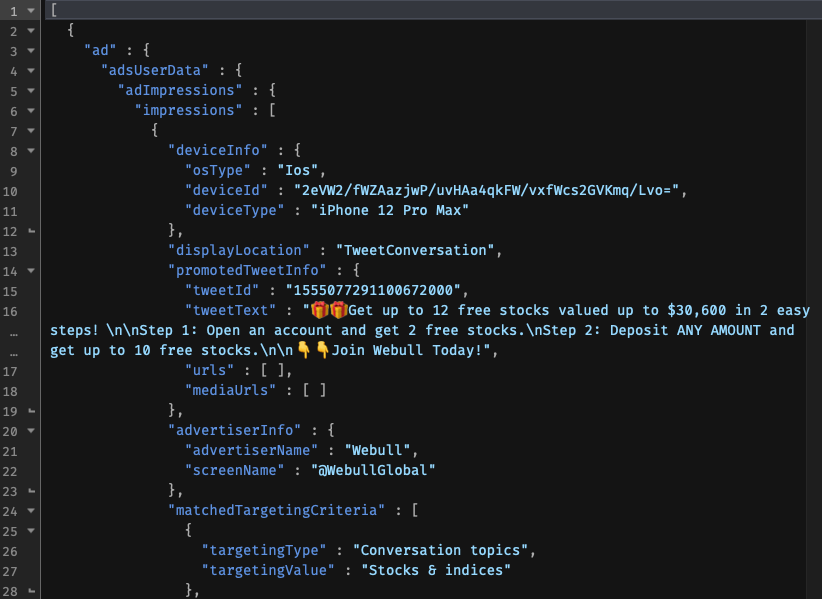
In the R programming language, the jsonlite and tidyjson libraries are the go-to tools to unpack JSON data and turn it into something easier to interpret. Even still, we can get a sense of what data is available to us.
Let’s unpack the data into a few basic charts so we can see who’s doing what.
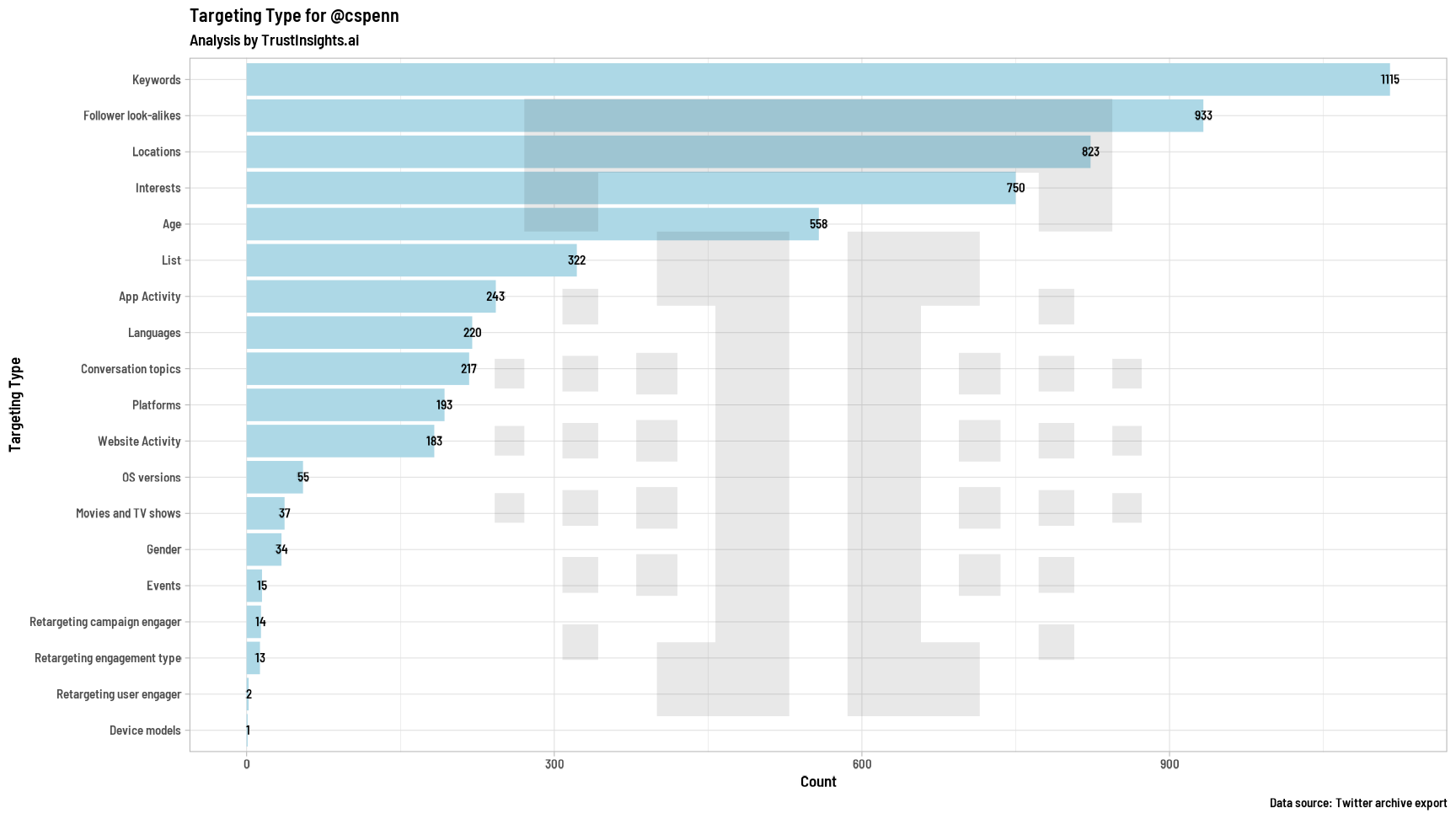
We start with the targeting types; advertisers target me most using keywords in tweets I post, followed by look-alike audiences, then locations. These aren’t mutually exclusive; companies can target by multiple criteria.
What are the keywords companies chase after?
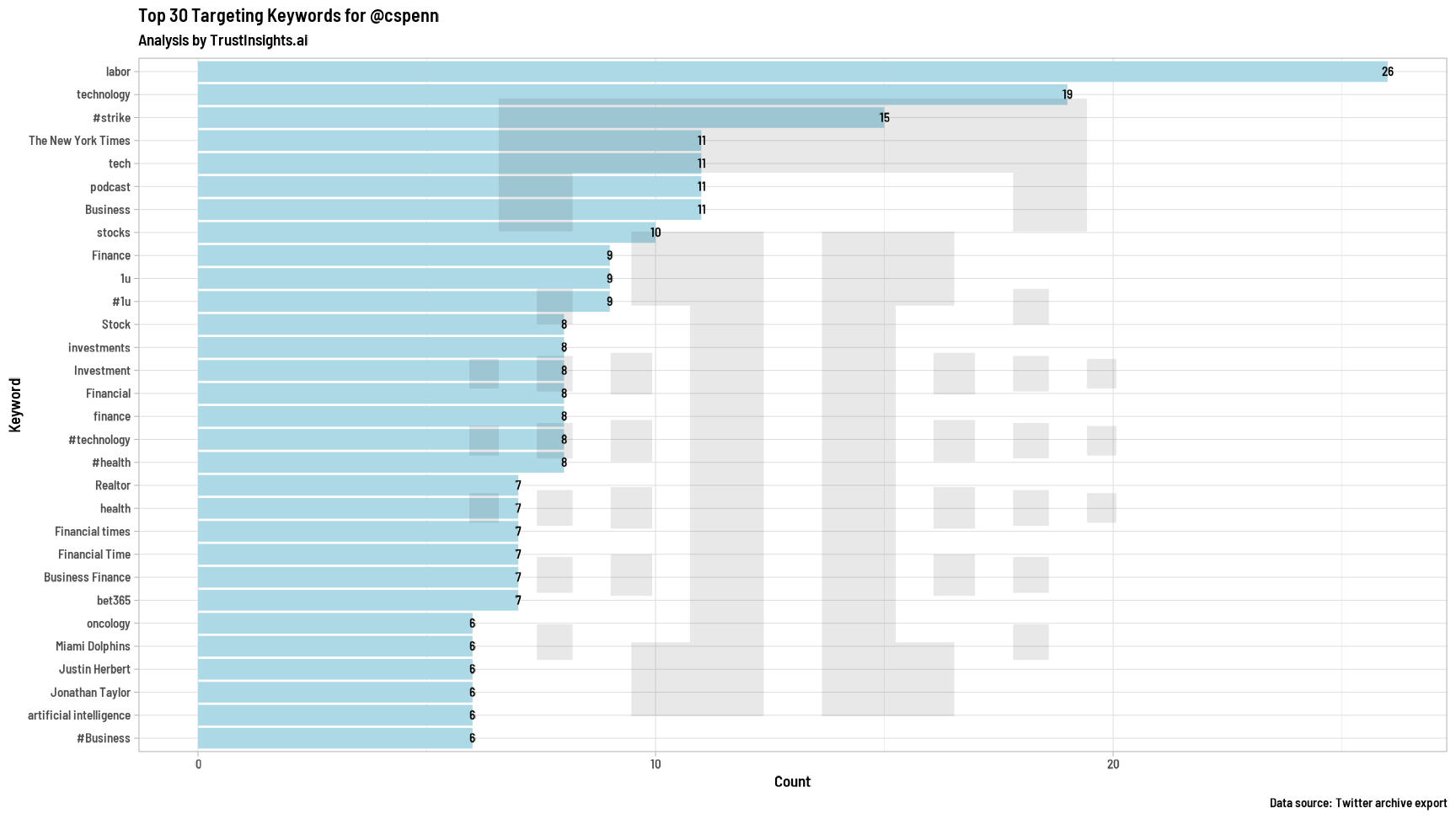
These are a peculiar set of keywords; I do talk about things like podcasts, and some finance stuff but it’s not the majority of my tweets. The health tweets I share are largely around COVID, so in general this targeting isn’t super precise.
Let’s dig into who’s advertising to me:
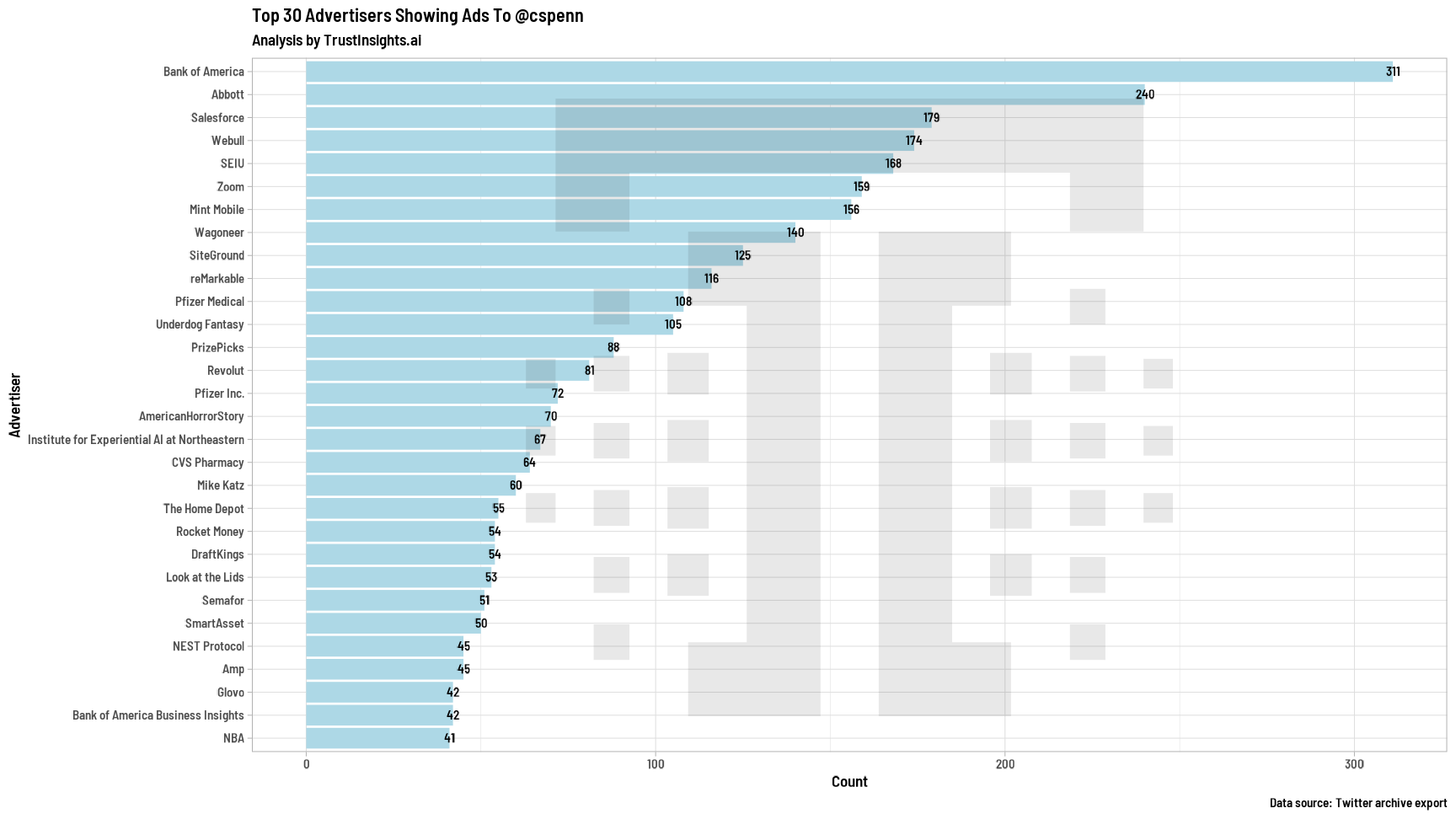
Bank of America and Abbott are trying really hard to reach me. Now, let’s dig into Bank of America and see how they’re trying to target me, and what the ad campaign is:
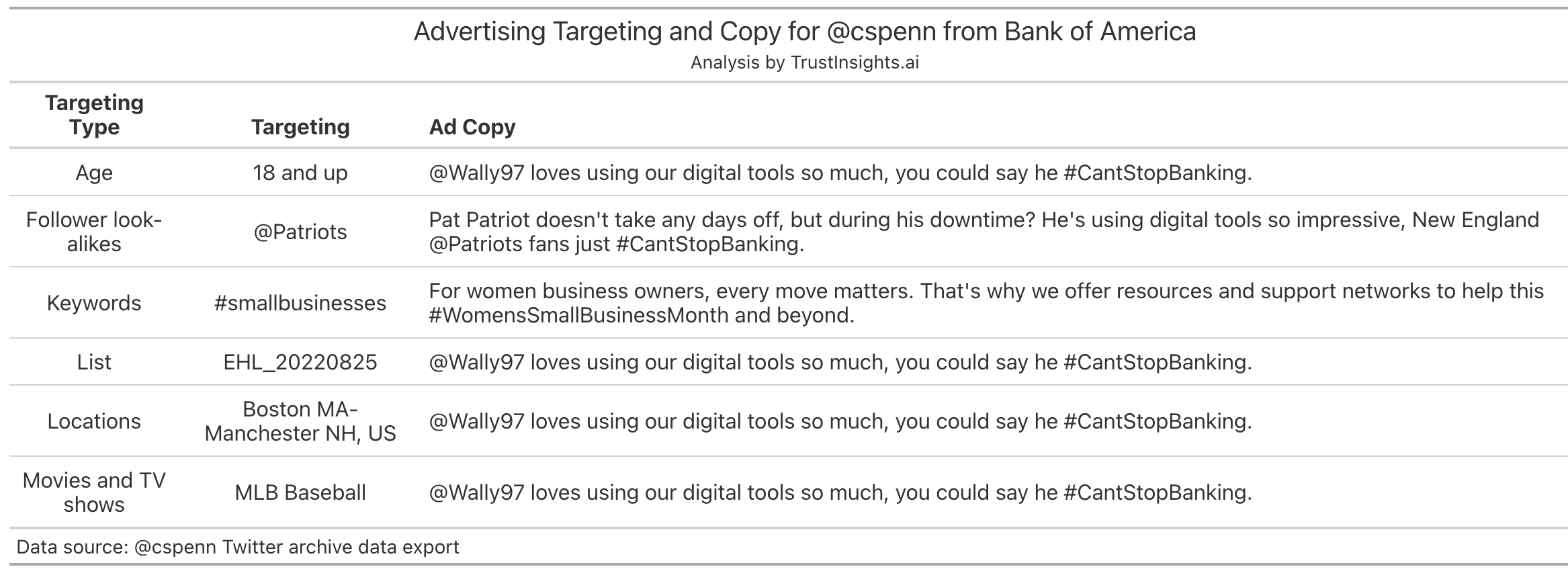
This entire campaign is targeted at people of my age group and location, people who are 18 and up in the metro Boston area who have shared content with #smallbusinesses. That’s the targeting, and the campaign is around two sports mascots, the New England Patriots mascot and the Boston Red Sox mascot.
How successful are these ads? Well, one look in the ad conversions JSON file tells us all we need to know: it’s empty. Not a single Twitter ad shown to me has converted for anything, ever.
These broad assumptions don’t fit me at all. I had to Google who these mascots were, I’m so out of touch with anything sports-related. I don’t follow either sports team, nor do I particularly care about what they have to say or who they endorse. It’s no wonder that I have zero conversions of any kind in my advertising profile data.
So what? What’s the point of this exploration? As a consumer, it’s helpful to know how advertisers are finding you, especially when you start to see ads that don’t make a lot of sense. As a marketer, this is a fantastic example of how a series of very broad assumptions can lead to ad targeting that’s… well, off target. If your ad performance isn’t what you expect it to be, take a hard look at your targeting options and match that up to what your market research is really telling you about your audience to refine your targeting. You might get fewer basic KPIs like leads, but your quality should improve substantially.

- New! Case Study: Exploratory Data Analysis and Natural Language Processing
- Case Study: Google Analytics Audit and Attribution
- Case Study: Natural Language Processing
- Case Study: SEO Audit and Competitive Strategy

Here’s a roundup of who’s hiring, based on positions shared in the Analytics for Marketers Slack group and other communities.
- Brand And Digital Marketing Manager at LHH
- Digital Marketing Director at Merritt Group
- Director Of Data Science at Storm6
- Director, Demand Generation at Vivantio
- Group Director Of Data And Perforamnce at Spinutech
- Marketing Manager at Taylor & Francis Group
- Senior Digital Analyst at Cancer Research UK
- Senior Manager, Strategy And Analytics at Mission Lane
- Svp Marketing at Propel

Are you a member of our free Slack group, Analytics for Marketers? Join 2900+ like-minded marketers who care about data and measuring their success. Membership is free – join today. Members also receive sneak peeks of upcoming data, credible third-party studies we find and like, and much more. Join today!

We heard you loud and clear. On Slack, in surveys, at events, you’ve said you want one thing more than anything else: Google Analytics 4 training.
We heard you, and we’ve got you covered. The new Trust Insights Google Analytics 4 For Marketers Course is the comprehensive training solution that will get you up to speed thoroughly in Google Analytics 4.
What makes this different than other training courses?
- You’ll learn how Google Tag Manager and Google Data Studio form the essential companion pieces to Google Analytics 4, and how to use them all together
- You’ll learn how marketers specifically should use Google Analytics 4, including the new Explore Hub with real world applications and use cases
- You’ll learn how to determine if a migration was done correctly, and especially what things are likely to go wrong
- You’ll even learn how to hire (or be hired) for Google Analytics 4 talent specifically, not just general Google Analytics
- And finally, you’ll learn how to rearrange Google Analytics 4’s menus to be a lot more sensible because that bothers everyone
With more than 5 hours of content across 17 lessons, plus templates, spreadsheets, transcripts, and certificates of completion, you’ll master Google Analytics 4 in ways no other course can teach you.
Click/tap here to enroll today »

Where can you find Trust Insights face-to-face?
- MarketingProfs Ugly Sweater Panel, December 2022, Online
- Women in Analytics GA4 Mini Tutorial, December 2022, Online
Going to a conference we should know about? Reach out!
Want some private training at your company? Ask us!

First and most obvious – if you want to talk to us about something specific, especially something we can help with, hit up our contact form.
Where do you spend your time online? Chances are, we’re there too, and would enjoy sharing with you. Here’s where we are – see you there?
- Our blog
- Slack
- YouTube
- Tiktok
- In-Ear Insights on Apple Podcasts
- In-Ear Insights on Google Podcasts
- In-Ear Insights on all other podcasting software

Our Featured Partners are companies we work with and promote because we love their stuff. If you’ve ever wondered how we do what we do behind the scenes, chances are we use the tools and skills of one of our partners to do it.
- Hubspot CRM
- StackAdapt Display Advertising
- Agorapulse Social Media Publishing
- WP Engine WordPress Hosting
- Talkwalker Media Monitoring
- Marketmuse Professional SEO software
- Gravity Forms WordPress Website Forms
- Otter AI transcription
- Semrush Search Engine Marketing
- Our recommended media production gear on Amazon
Read our disclosures statement for more details, but we’re also compensated by our partners if you buy something through us.

Some events and partners have purchased sponsorships in this newsletter and as a result, Trust Insights receives financial compensation for promoting them. Read our full disclosures statement on our website.

Thanks for subscribing and supporting us. Let us know if you want to see something different or have any feedback for us!







2 thoughts on “INBOX INSIGHTS, November 30, 2022: Weakened Communities, Twitter Ad Targeting”